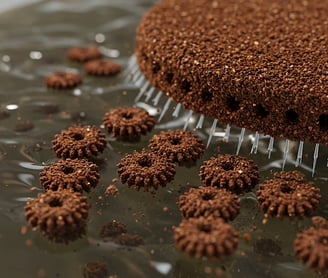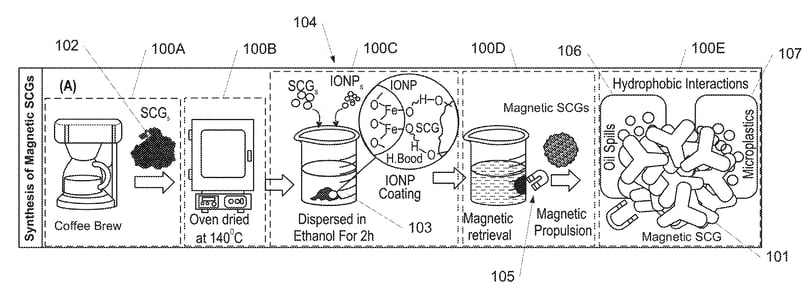Coffee Ground based Microbots for Purifying Water
SUSTAINABILITYBEVERAGES


This is an AI generated illustration and does not represent actual product or service.
Water pollution is one of the most pressing environmental challenges of our time, with contaminants such as industrial dyes, microplastics, and oil spills posing significant threats to aquatic ecosystems and human health. Traditional water treatment methods, while effective, often require substantial energy, land, and financial resources, making them inaccessible to many communities worldwide. In response, researchers at George Mason University have developed an innovative, sustainable solution: coffee ground-based microbots capable of efficiently removing pollutants from water. This technology leverages spent coffee grounds, a widely available waste product, to create magnetically controlled microbots that can tackle a variety of water contaminants.
The Problem: Water Pollution and Its Challenges
Water pollution arises from various sources, including industrial waste, agricultural runoff, and oil spills. Among the most harmful pollutants are:
1. Industrial Dyes: Toxic and non-biodegradable, these dyes are released by industries such as textiles, plastics, and cosmetics, causing long-term harm to aquatic life and human health.
2. Microplastics: Tiny plastic particles that persist in water bodies for centuries, microplastics absorb harmful chemicals and enter the food chain, ultimately affecting human health.
3. Oil Spills: Oil spills from offshore drilling or shipwrecks form thick surface films, blocking sunlight and oxygen exchange, devastating marine ecosystems.
Conventional water treatment methods, such as filtration and coagulation, are often costly, energy-intensive, and ineffective at removing all types of contaminants. There is a critical need for affordable, scalable, and sustainable solutions to address water pollution.
The Innovation: Coffee Ground-Based Microbots
George Mason University’s patent application (US20250017234A1) introduces a novel method for creating magnetic microbots from spent coffee grounds (SCGs). These microbots are designed to remove pollutants such as oil, microplastics, and industrial dyes from water. The key innovation lies in the use of iron oxide nanoparticles (IONPs) to magnetize the coffee grounds, enabling precise control and retrieval of the microbots using an external magnetic field.
The microbots are created through a green chemistry approach, which avoids toxic chemicals and high temperatures, making the process environmentally friendly and cost-effective. Here’s how it works:
1. Magnetization: Spent coffee grounds are dried and mixed with iron oxide nanoparticles in an ethanol solution. The IONPs bond to the coffee grounds through hydrogen bonding, imparting magnetic properties.
2. Functionalization: To enhance their pollutant-removal capabilities, the magnetized coffee grounds are coated with ascorbic acid (vitamin C), which aids in breaking down industrial dyes.
3. Deployment: The microbots are introduced into contaminated water, where they capture pollutants through hydrophobic interactions and magnetic propulsion.
How the Microbots Work
The coffee ground-based microbots leverage their unique properties to remove contaminants:
1. Oil and Microplastics Removal: The hydrophobic nature of coffee grounds allows them to attract and capture oil droplets and microplastics. The magnetic properties enable easy retrieval of the microbots after cleanup.
2. Dye Degradation: When coated with ascorbic acid, the microbots break down industrial dyes like methylene blue through a chemical reduction process, converting them into harmless byproducts.
3. Magnetic Control: An external magnetic field guides the microbots through the water, ensuring efficient pollutant removal and enabling their recovery for reuse.
Key Advantages of the Technology
1. Sustainability: The microbots are made from spent coffee grounds, a renewable and abundant waste material, reducing the environmental footprint of water treatment.
2. Cost-Effectiveness: The use of low-cost materials and a simple manufacturing process makes this technology accessible to developing regions.
3. Versatility: The microbots can remove a wide range of pollutants, including oil, microplastics, and industrial dyes, making them a versatile solution for water purification.
4. Reusability: The microbots can be cleaned and reused multiple times, further enhancing their sustainability and cost-efficiency.
Applications and Impact
This innovative technology has the potential to transform water treatment in various settings:
1. Industrial Wastewater Treatment: Factories can use the microbots to remove dyes and other pollutants from their effluent before discharge.
2. Oil Spill Cleanup: The microbots can be deployed to quickly and efficiently remove oil spills from oceans and rivers, minimizing environmental damage.
3. Microplastic Removal: The microbots can capture microplastics from water bodies, preventing their entry into the food chain.
4. Community Water Purification: The low-cost and scalable nature of this technology makes it ideal for providing clean water in underserved communities.
Experimental Results
The microbots have demonstrated remarkable efficiency in laboratory tests:
- Oil Spill Cleanup: The microbots achieved a 99% oil separation efficiency in just 3 minutes.
- Dye Degradation: Microbots coated with ascorbic acid removed 93% of methylene blue dye from water within 40 minutes.
- Microplastic Removal: The microbots captured 64% of polystyrene microbeads from seawater in 1 hour.
George Mason University’s coffee ground-based microbots represent a significant leap forward in sustainable water purification. By transforming a common waste product into a powerful tool for environmental remediation, this technology offers a cost-effective, eco-friendly solution to one of the world’s most pressing challenges.
As the global demand for clean water continues to grow, innovations like these will play a crucial role in ensuring a sustainable future. For industries, governments, and communities seeking effective and affordable water treatment solutions, this groundbreaking technology provides a promising path forward.


